Ever-changing yet always stunning, the Naples Botanical Garden on Florida’s west coast is a special place to learn about nature and enjoy the outdoors, visit after visit.
If you are a first timer, you are bound to be impressed from the moment you approach the entrance. A lush landscape features plenty of color from bromeliads and other plants, a water-lily-studded pool dappled with sunlight coming through palm fronds and the soothing sound of water falling.
And you see this landscape before even entering the garden grounds.

If you are a repeat visitor to the Naples Botanical Garden, you are bound to discover an ever-changing variety of plants and art exhibits as well as the seasonal rotation of blooming trees, flowers and orchids.
To make repeat visits even more rewarding, the garden features a different theme every year that can mean whole areas undergoing replanting and change.
Although the garden covers 170 acres, only 80 of these are cultivated. The remainder are permanent conservation areas including wetlands and scrublands with mostly paved trails throughout.
How the Naples Botanical Garden came to be
This well-loved, well-designed and well-maintained garden is in large part the result of patrons and other entities being generous with their time and donations.
In fact, one of the first donation was for $5 million made in 2000 by the late Harvey Kapnick, Jr. The money was used to purchase 170 acres of open space three miles from downtown Naples to create what would become a botanical garden.
In 2006, a “dream team” of architects and landscape designers (including Ellin Goetz, Ted Flato, Raymond Jungles, Herb Schaal, Bob Truskowski and Made Wijaya) completed the master plan for the Naples Botanical Garden.
Beginning in 2008, garden construction included the digging of Deep Lake and Lake Tupke. At the same time, the site was sculpted by adding 250,000 cubic yards of fill taken from the lakes as they were excavated.
In 2009, the garden opened with only a few of its planted areas ready for visitors. But by 2014, the master plan had been fully implemented.
Since that time, the garden has grown in scope and popularity until today it has about 200 volunteers and 200 staff members welcoming 260,000 visitors annually.
naples-garden-mapNaples Botanical Garden map: Plot your course but be ready for some surprises along the way. Map courtesy of the Naples Botanical Garden.
11 surprises at the Naples Botanical Garden
During your visit to the Naples Botanical Garden, you’ll discover there are eight garden areas and two natural preserves. These are described on the garden’s website and can be located with help of the Garden Map. All are easy to get to and explore.
Of course, they are all worth a visit and you can see them all or pick and choose depending on your interests.
But before you do that, take a look at some of the more surprising perks and places we found during a visit to the Naples Botanical Garden.
1. In search of ghosts
No, we aren’t talking about the spooky kind. Instead, head to Sönne Family Ghost Orchid Boardwalk to see the Ghost Orchids that are being nurtured there as well as other places in the state.
It’s a little out of the way. But a chance to see these prized and rare orchids without a trip into a swamp is worth the effort. (The orchids usually bloom in summer.) At the Naples Botanical Garden, research into conserving these wild beauties is ongoing. For more information, read the Orchid Whisperer on page 13 and 14 of this publication.
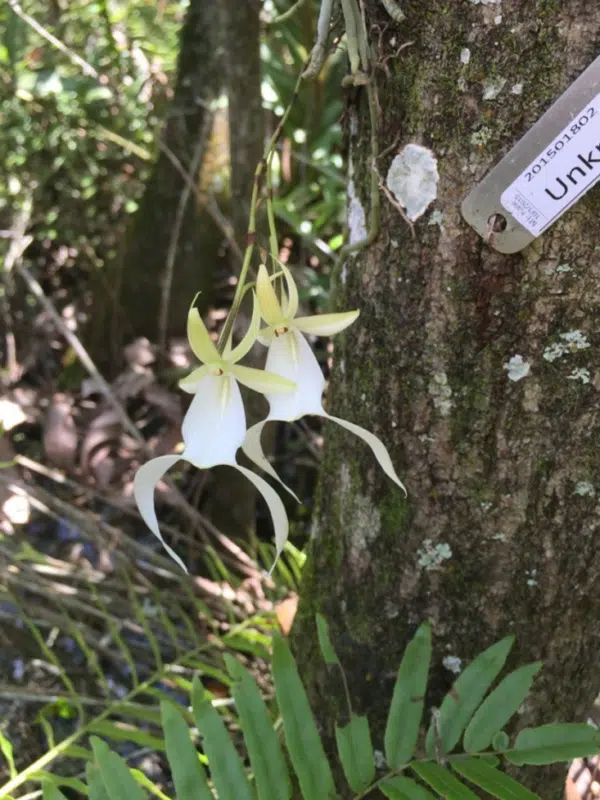
2. A hidden labyrinth
I didn’t see it on the Garden Map but there it was in the South Grove. A labyrinth was beckoning me to follow its red stone matrix.
Unlike a maze where you must choose your path, this labyrinth winds its way directly to the center. As you slowly follow the path, you can use the time to focus yourself. Your journey can help you be in the right frame of mind to enjoy the rest of the garden.
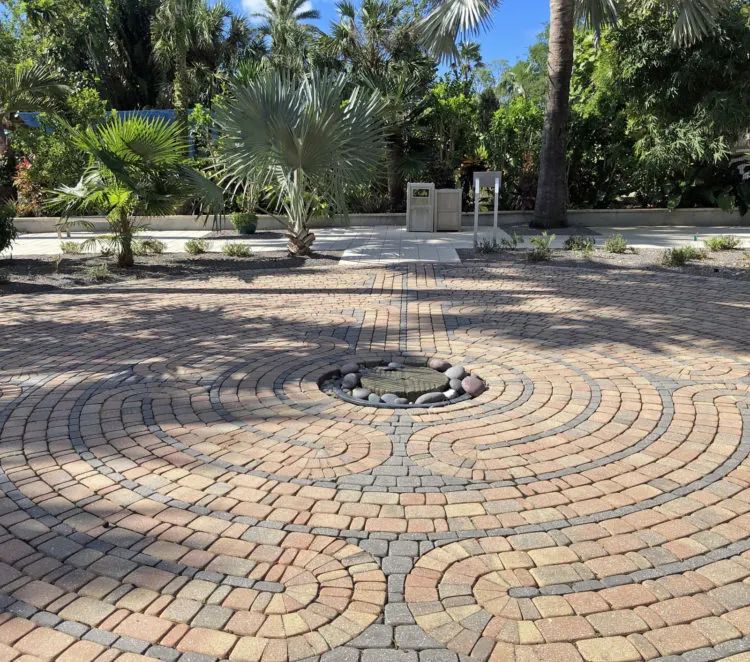
3. Dog friendly
If you don’t want to leave your best friend at home, the garden welcomes one well-behaved dog per adult in its outdoor areas from 8 a.m. to 11 a.m. on Sundays and Tuesdays.
Dogs must be tethered on non-retractable leashes and you must clean up after them. Admission for your dog is $15 plus your admission fee; members and their dogs, free. A collapsible bowl is recommended so your dog can get a drink at a water fountain.
If you are visiting with your dog for the first time, please fill out this form before you arrive.
4. Special recipe and simpatico chef
The Fogg Café is a great place to stop for lunch or to take a break. You order from a menu at the counter and the casual but fresh food is delivered to your table inside or out.
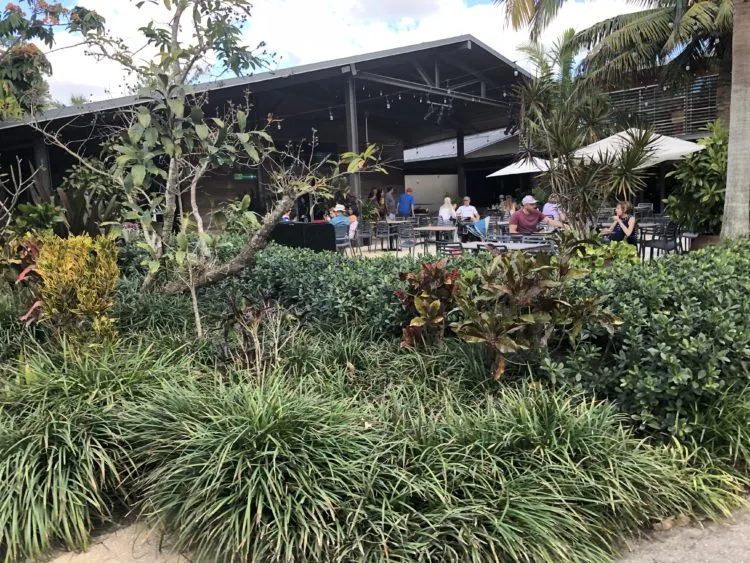
The food is made inhouse and changes with the seasons so things are fresh tasting.
After enjoying a refreshing watermelon salad from the menu, I couldn’t determine what made its herbed vinaigrette so satisfying. When I asked about it at the counter, a chef came right over, went in the kitchen and returned with a copy of the recipe to give me.
Now I am the proud owner of the complete directions for making the salad. And the difficult-to-determine dressing ingredients? Mint, basil and rice vinegar. Thank you, chef.
5. Love those lily pads
In the Kapnick Brazilian Garden, you’ll see a garden-sized tribute to Roberto Burle Marx, a Brazilian landscape designer and artist famous for creating the black-and-white wave-like sidewalk along the Copacabana Beach in Rio de Janeiro.
At the Naples garden, you’ll see a stunning water feature with a three-level waterfall and at the top of it is a mosaic by the artist who passed away in 1994.
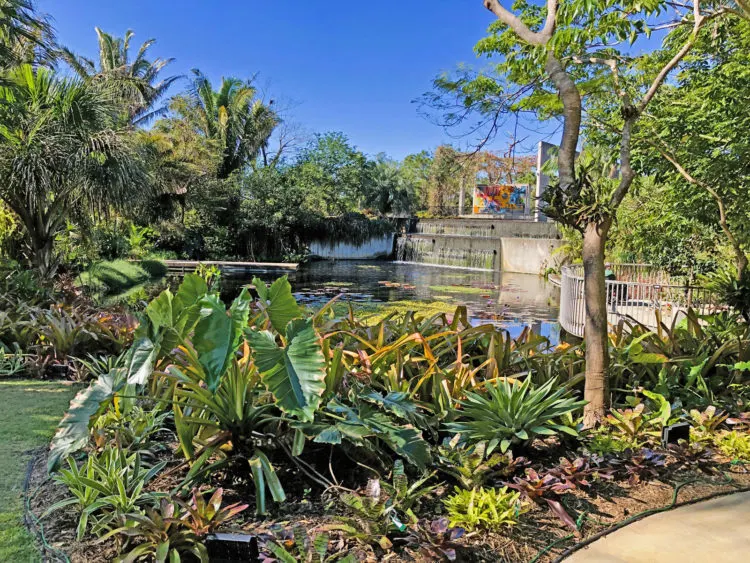
Sure, the water feature is beautiful and a must-see at the garden.
But what really fascinated me was the use of water lilies with floating pads reminiscent of inverted frisbees. One of three varieties of water lilies in the garden, these are the Victoria Boliviana. And here in the garden, their lily pads measure about a foot in diameter.
But in Bolivia, where growing conditions are ideal, the pads of the Victoria Boliviana can grow to 10 feet across and up to seven inches a week. That’s why the pads are covered with prickles so they can push other water plants out of their way as their pads grow.
![Naples Botanical Garden: 11 surprises at a stunning spot 6 This image has an empty alt attribute; its file name is lily-pads.jpg
Bolivia is home to lilies with over-sized pads. Photo by Martha Lucia Morgan.[DH1]](https://www.floridarambler.com/wp-content/uploads/lily-pads.jpg.webp)
In their native land, the lilies are pollinated by scarab beetles. It’s an amazing process in which the flower attracts the beetle by taking advantage of the bug’s sense of sight (it sees the white flowers), sense of smell (the flower exudes a tempting pineapple scent) and even its body temperature (once the bowl-shaped flower closes around the beetle, it is 10 degrees warmer within the flower than outside). The process must happen quickly as the flower lives for only two nights. After it is over, the plant turns from female to male so that it can release pollen to coat the beetle.
Of course, these beetles don’t live in Florida so the lilies at the botanical garden are hand pollinated.
Even so, here the flowers of these lilies, like their Bolivian cousins, change color from white to purplish pink after pollination. It’s nature’s way of telling the world the lily has had enough and the pollinator – whether human or beetle – can move on to the next plant.
Rambler Tip: Summer is the best time to see water lilies in the Naples Botanical Garden as they die off when it’s cold.
6. Stickwork sticks around
The Naples Botanical Garden is proud to have an oversized “stickwork sculpture” called Sea Change. It was created especially for the botanical garden in 2021.
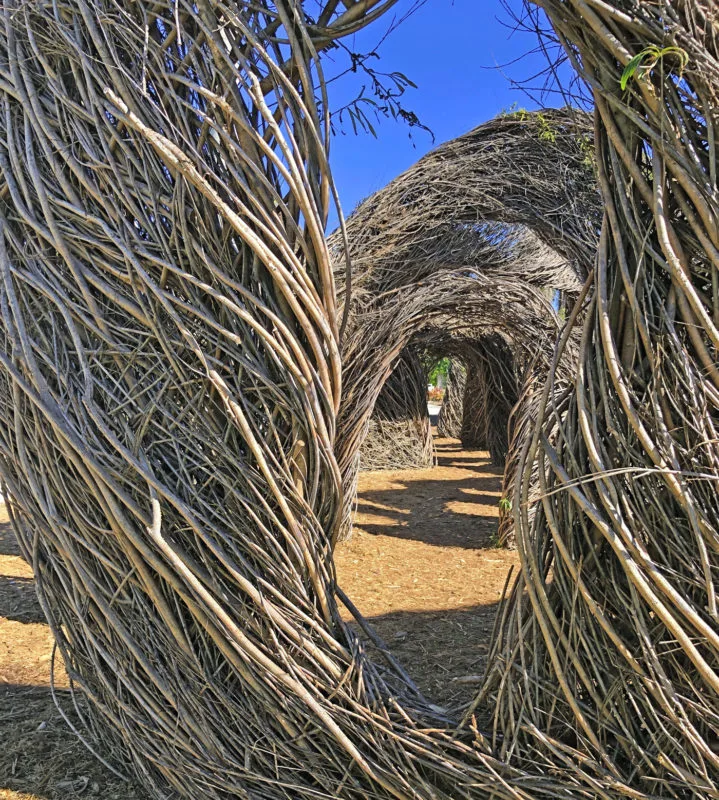
In creating this sculpture, the artist Patrick Dougherty and his son worked for 17 days aided by about a dozen volunteers. Together they wove 3,000 pounds of willow saplings to make this wave-like sculpture you can actually walk through.
The sculpture is expected to last about two years before falling apart naturally. But right now, it seems to be doing very well having survived Hurricane Ian!
7. The W.O.N.D.E.R of it all
As I walked the garden, I saw children with adults sitting at tables and on benches intently coloring, talking or reading materials from a white envelope.
I learned that they were using their W.O.N.D.E.R. Discovery Packages available free at the Visitor Center.
Wonder what W.O.N.D.E.R. stands for? Well, wonder no more.
It’s an acronym for Walk, Observe, Navigate, Draw, Explore and Read. And that’s how these activity packages help you and your children explore the garden. The themed activities change monthly.
8. Tech in the garden
If you decide to take one of the garden tours included with your admission, you won’t be part of a big crowd led by a straining guide who you can’t hear anyway.
Instead, you’ll have your own comfortable over-ear listening device hooked to a transmitter hanging from a lanyard.
This connects you to a microphone wired to the guide. As a result, you hear everything the guide says sans jockeying for position. And the guide doesn’t have to shout.
The ear piece can be used by those with hearing aids. The guides also carry small computers that help them show and tell.
If you don’t want to take an organized tour, there are stations throughout the garden that have QR codes on them. Scan these codes to learn more about what you are seeing. It’s an on-demand, self-guided tour.
If you have a question while you are visiting the garden, signs provide a phone number you can text to have your questions answered.
Rambler Tip: Remember to bring your phone and be sure it’s charged.
9. More than meets the eye
The Eleanor and Nicholas Chajabra Visitor Center is where you pay your admission, sign up for tours and then meet your guide.
Be sure to sign up for tours at the information table and use the restrooms. (These are the only facilities on the property).
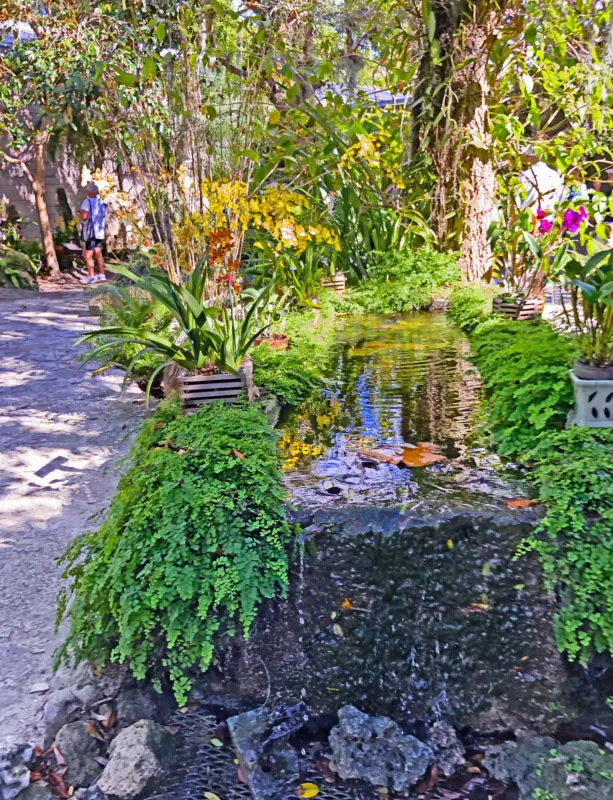
Tucked into spaces in this building, you’ll find Irma’s Garden filled with colorful flowers; Kathryn’s Garden offering a lush tropical landscape reminiscent of the Post-Impressionist paintings of French artist Henri Rousseau; and the LaGrippe Orchid Garden with color everywhere you look.
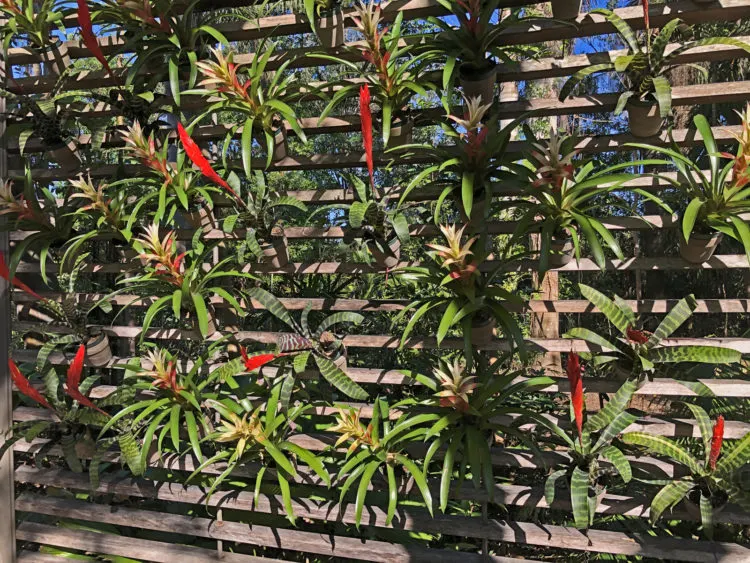
The building itself is constructed of antique bald cypress that was harvested from Florida’s forests in the late 1800s. At that time, the old-growth trees could easily have been from 1,000 to 3,000 years old.
To get these behemoths from forest to sawmill, they were floated down waterways. During the trip, some sank. And it’s these “sinker cypress” that were preserved for 100 years in the cool, oxygen-free waters where they landed.
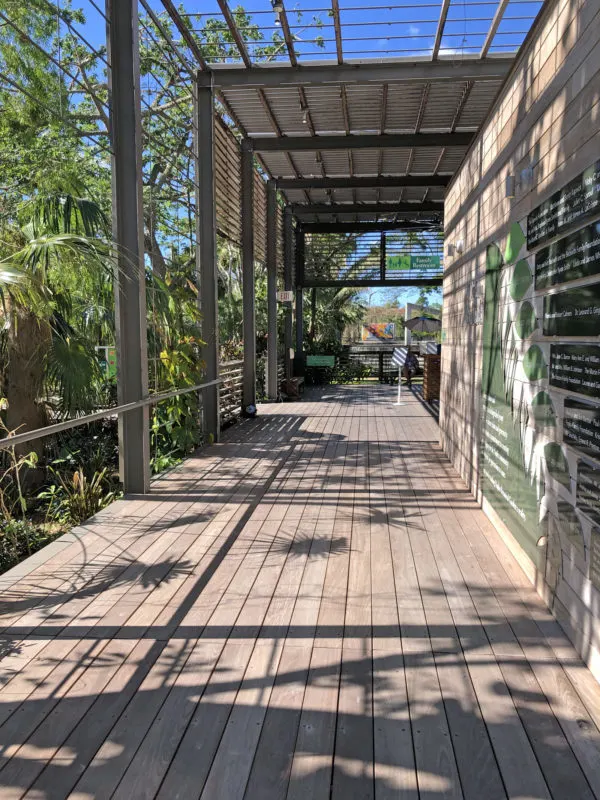
10. A Balinese master piece
Visiting the Thai Riverside Pavilion in the Lea Asian Garden, you may not realize the craftsmanship that went into creating it. Built by artists in Bali, the ceiling alone is made of 10,000 pieces of Balinese teak that was sustainably grown and harvested. After its creation, the entire work was taken apart and shipped to the garden.
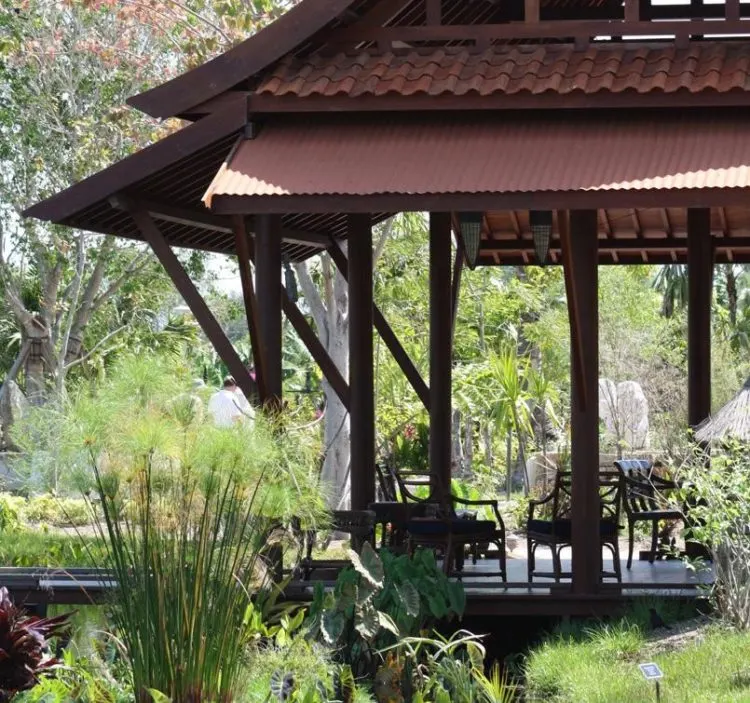
The same Balinese workers were brought to Naples where they reassembled the pavilion in the Asian-themed garden. Today it is one of the coolest places to sit and enjoy the Naples Botanical Garden.
11. A sign of the times
When your Botanical Garden visit is over, this sign may get you into the right frame of mind to take your leave:
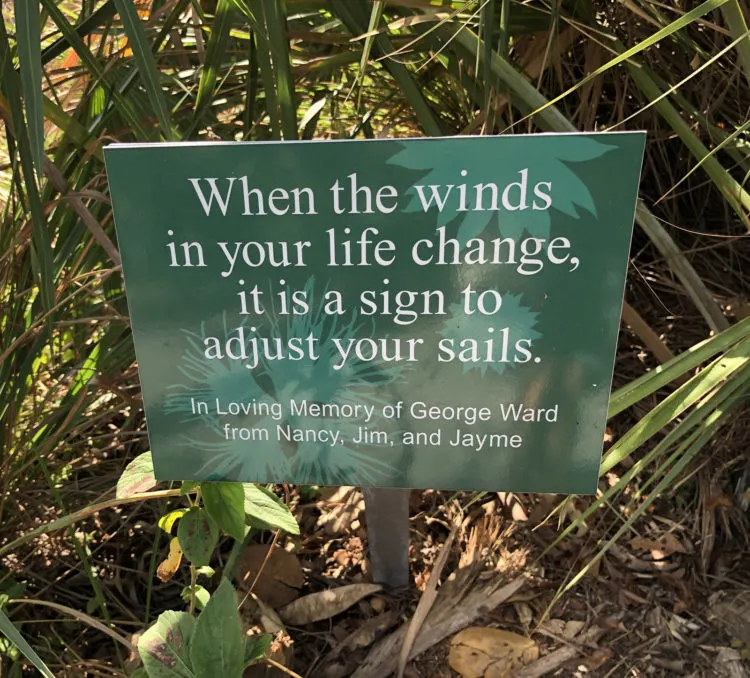
Hurricane Ian, an unwelcome guest
On Sept. 28, 2022, Hurricane Ian made a direct hit on the southwest coast of Florida with about 150 mph maximum sustained winds at landfall. But lucky for Naples, the center of the storm hit about 80 miles north in the Fort Myers/Sanibel area.
When the rain and winds stopped, the Gulf of Mexico waters receded and the sun came out, some beach-side residents of Naples found themselves with flooding, damaged homes and the iconic Naples Pier had whole sections damaged or destroyed.
But because the Naples Botanical Garden sits about 2 miles east of the Gulf of Mexico, its damage was not severe. Heavy winds mostly snapped branches instead of toppling trees.
By the time the Naples Botanical Garden reopened after being closed for about 1 ½ months, storm refuse, including 35 trees, had been removed. Of the remaining plantings, 15 trees had been righted. And the affected foliage had been washed with fresh water to remove salt that could cause further damage.
If you go to the Naples Botanical Garden
- Where: Naples Botanical Garden, 4280 Bayshore Dr., Naples
- Hours: The garden is open 9 a.m. to 5 p.m. daily; members only, 8 a.m. to 9 a.m. The Fogg Café and Berger Gift Shop, both in the Eleanor and Nicholas Chajabra Visitor Center, are open 9 a.m. to 5 p.m. To enjoy the gift shop or restaurant, you need to purchase Garden Admission.
- Garden Admission: Adults, $25; children 4 -17, $10; children under 4, free; members free. Admission includes participation in daily tours and garden art exhibits. Admission and event tickets can be bought online.
- The garden also participates in the Bank of America Museums on Us program on the during the first full weekend of each month.
- Garden Tours: A variety of 45-minute garden tours are included in the price of admission. But you need to sign up at the Information Station Kiosk on the Smith Entry Prow at the back of the Visitor Center. Group size is limited to 16 people so if you want a particular tour at a particular time, you may want to sign up as you enter the garden. Here’s a schedule of tours.
- Garden Wedding: Weddings and wedding photo shoots are not allowed in the garden. And the garden has a rather strict photography policy that, depending on how the photos will be used, may require you to schedule your shoot and pay a fee . For more information visit here or contact [email protected] or 239-325-1354.
- Printable Garden Map: NBGMap2019.pdf (naplesgarden.org)
- More Info: 239-643-7275; Naples Botanical Garden; [email protected]
Author’s Note: I want to thank Renee Weller, Director of Communications and Marketing at Naples Botanical Garden, as well as Lilli Ganstrom, a member of the Education and Visitor Experience team, for the information and help they gave me while I researched this article.– Deborah Hartz-Seeley
More resources from Florida Rambler for visiting Naples
12 things to do outdoors in the Naples area.
Hiking and wildlife at Bird Rookery Swamp
Audubon Corkscrew Swamp Sanctuary: Exquisite boardwalk in a cypress swamp
The Tamiami Trail for a scenic trip through the Everglades, with interesting stops

Deborah Hartz-Seeley is a Master Gardener whose yard is certified as Florida Friendly. With a master’s degree in agricultural journalism, she’s written for the Sun-Sentinel, Miami Herald, The Coastal Star, Cook’s Magazine, Florida Food & Farm and Florida Design. If she’s not out back growing things, you’ll find her wandering a garden path or exploring nature on foot, on a bike or in a kayak.
